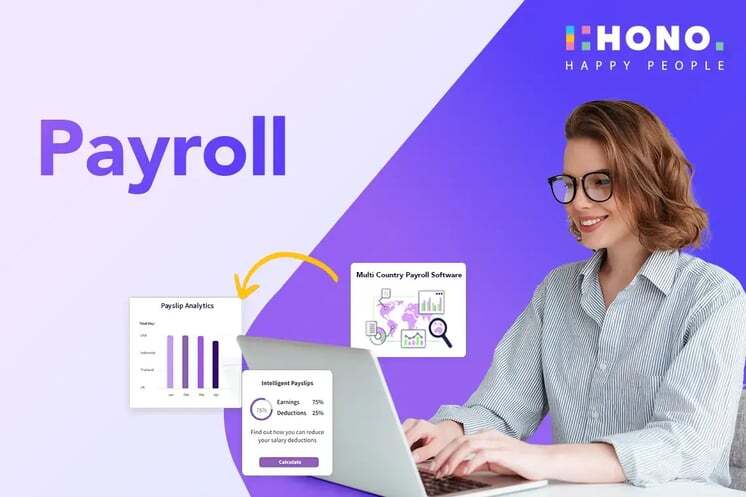What is Payroll?
Payroll refers to the process of calculating and distributing employee salaries. It includes tracking work hours, calculating gross pay, applying deductions like taxes or insurance, and issuing net pay. A reliable Payroll Management System helps businesses handle this process with accuracy and consistency.
The basic payroll calculation looks like this:
Net Salary = Gross Salary – Deductions
Here are the main components involved in payroll :
- Basic salary: the fixed part of an employee’s pay
- Allowances: such as housing, travel, or medical allowances
- Bonuses or incentives: performance-based or seasonal payments
- Deductions: like tax, provident fund, or insurance contributions
- Net salary: the final amount paid after all deductions
Using payroll processing software, businesses can automate these calculations, reducing the risk of errors and delays. The Best Payroll Software also offers features like payslip generation, tax filing, and integration with accounting tools.
Why is Managing Payroll So Important?
Accurate payroll management is essential for letting the employees have a fair pay calculation and staying compliant with tax laws. Mistakes in salary calculations or delayed payments can lead to employee dissatisfaction and even further legal issues. A Payroll Management System helps avoid such problems by ensuring timely and correct salary processing.
Using a trusted payroll processing software also helps companies maintain proper records, manage deductions, and file taxes without missing deadlines. The Best Payroll Software provides reminders, compliance checks, and audit-ready reports, making it easier to follow labor laws and financial regulations. In short, effective payroll management builds employee trust and protects your business from penalties.
Stages of Processing Payroll
Running payroll involves more than just calculating salaries. It’s a step-by-step process that ensures employees are paid correctly, records are maintained, and all legal requirements are met. A well-structured Payroll Management System breaks down this task into three main stages: pre-payroll, payroll processing, and post-payroll. Each stage plays a key role in ensuring smooth operations.
Here’s how the payroll process typically works:
Pre-Payroll Activities
Before running payroll, you need to gather accurate employee data—such as attendance, leave balances, and any bonuses or deductions. Payroll policies should also be updated as per company rules and legal standards. Good payroll processing software automates data collection by integrating with attendance and HR systems.
The Actual Payroll Process
This stage involves calculating gross pay, deductions (like taxes, provident fund, insurance), and net pay. A reliable Payroll Management System performs these calculations automatically, reducing the risk of manual errors and delays.
Post-Payroll Process
Once employee salaries are calculated, the process doesn’t end there. Several important tasks must be completed to ensure compliance, maintain accurate financial records, and make timely payments. A good Payroll Management System helps manage these activities efficiently by automating workflows and reducing manual effort.
Here’s what happens after payroll is processed:
- Compliance: Statutory deductions such as income tax, PF, and ESI must be deposited with government bodies. The Best Payroll Software helps generate and submit these reports on time.
- Accounting: Payroll expenses must be recorded in the company’s books. Software with accounting integration ensures accurate entries.
- Payout: Net salaries are transferred to employees’ bank accounts. Payroll software can automate bulk payments through bank integration.
- Report: Reports on salary payments, tax filings, and deductions help with audits and decision-making. Most payroll processing software allows you to download detailed reports as needed.
Challenges in Handling Payroll Management
Managing payroll manually or with outdated tools can lead to frequent issues. Without a proper Payroll Management System, businesses face the risk of delays, miscalculations, and non-compliance.
Some common challenges include:
- Manual errors: Incorrect data entry can result in wrong salary payments or missed deductions.
- Compliance risks: Tax laws and labor rules change often. Failing to stay updated can lead to penalties.
- Time-consuming processes: Collecting attendance data, calculating pay, and filing taxes can take hours without payroll processing software.
- Lack of transparency: Without proper records, it’s hard to track historical payroll data or respond to employee queries.
- Data security: Handling sensitive employee information without secure systems increases the risk of data breaches.
Using the Best Payroll Software helps address these issues by automating processes, updating compliance settings, and keeping employee data secure.
Methods Available to Do Payroll Management
There are several ways companies can handle payroll, and the choice often depends on business size, budget, and the number of employees. Smaller businesses sometimes use manual methods or spreadsheets to manage salaries, but these options are time-consuming and prone to errors. Outsourcing payroll to third-party providers is another option, though it can be costly and offers less control over sensitive data.
For most growing businesses, using a Payroll Management System is the most efficient solution. With the help of modern payroll processing software, businesses can automate salary calculations, handle deductions, manage tax filings, and generate payslips. The Best Payroll Software also provides employee self-service features, integrates with accounting tools, and ensures compliance with the latest tax laws, making payroll management faster, easier, and more reliable.
Key Benefit of Payroll Software
Using a Payroll Management System makes payroll handling faster, more accurate, and less stressful. It reduces manual work and helps businesses stay compliant with legal requirements.
Key benefits include:
- Automates salary calculations, tax deductions, and payslip generation
- Reduces the chances of errors and payment delays
- Saves time by simplifying repetitive tasks like attendance tracking and compliance filing
- Improves data security and allows easy access to reports and records through the payroll processing software
The Best Payroll Software brings all these features together, making payroll management smooth and reliable.
Read more: Payroll Processing: A Complete Guide with Steps, Types, and Challenges
Things to Look for in a Payroll Management Software
Choosing the right Payroll Management System is important for smooth and error-free salary processing. The software you select should match your business size, employee count, and compliance needs.
Here are key features to look for:
- Automation: The software should handle salary calculations, deductions, and tax filings without manual effort.
- Compliance support – It should stay updated with the latest tax rules and statutory regulations.
- Integration: Look for payroll processing software that works well with your existing HR and accounting tools.
- Employee self-service: Employees should be able to view payslips, tax details, and leave balances on their own.
- Scalability: The Best Payroll Software should grow with your business, supporting more users and features as needed.
- Data security: Make sure it offers strong access controls and data protection to keep employee information safe.
- Report generation: The system should allow you to download reports for audits, finance, and management reviews.
Choosing the right software can save time, reduce errors, and improve payroll accuracy across the organization.
Conclusion
Effective payroll management is essential for every business to ensure timely salary payments, accurate tax deductions, and compliance with regulations. A reliable Payroll Management System reduces manual work, minimizes errors, and provides clear records that help businesses stay organized and avoid penalties. Choosing the right software can make payroll simpler and more efficient, no matter the size of your organization.
One of the leading solutions in the similar curriculum is HONO, a platform designed to handle payroll across multiple countries from a single system. It offers centralized payroll processing, strong data security, and easy integration with HR and accounting tools. With features like an employee self-service portal and local expert support, HONO helps businesses manage payroll reliably and transparently.
By using HONO as your payroll processing software, your organization can save time, reduce risks, and stay updated with compliance requirements. Its scalable design makes it suitable for businesses at any stage, allowing teams to focus on growth and other priorities instead of payroll challenges.










